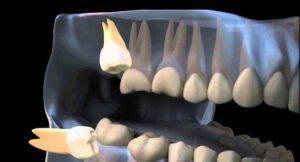 Appearance of wisdom teeth many people are waiting with concern. Wisdom teeth in themselves do not pose a health hazard, but often they do not appear in the place where they should be, which leads to inflammation of the gums and swelling of the mucous membranes.
Appearance of wisdom teeth many people are waiting with concern. Wisdom teeth in themselves do not pose a health hazard, but often they do not appear in the place where they should be, which leads to inflammation of the gums and swelling of the mucous membranes.
A wisdom tooth occupying an incorrect position in the mouth is called retinitis.
Anomalies of the dentition can lead to serious disorders, which complicate speech functions and chewing food.
Contents
- Causes of abnormal eruption
- Symptomatic features
- Possible complications
- What if the tooth grows on the cheek?
- Post-operative dentist recommendations
Reasons for improper eruption
Retinished teeth are fully formed. The reasons why they erupt in the wrong direction can be different, among them:
-
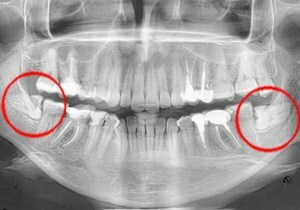
In the photo, the radiograph with two horizontal wisdom teeth
had infections;
- abnormal intrauterine development and malnutrition in infancy;
- abnormal position of molar primordia;
- presence of chronic systemic diseases;
- narrow gum;
- of the jaw pathology;
- heredity;
- is a powerful layer of the gum.
Embryological causes are of paramount importance. The laying of teeth occurs during the phase of early intrauterine development.
Problems with violation of teething may appear during the change of milk teeth to permanent teeth. If in this period there is a retention, wisdom teeth with a high probability will grow incorrectly.
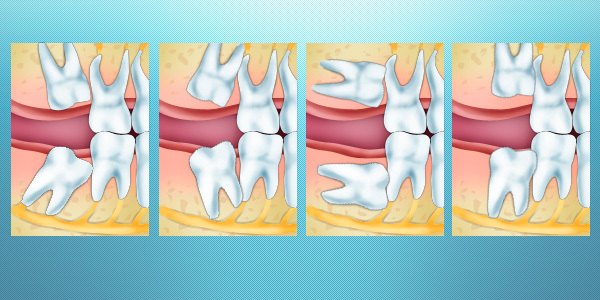
In the picture, the options for the growth of the wisdom tooth: the adjacent tooth, the cheek, horizontally, straight
Symptoms of
Symptoms of retention are very pronounced. First, it is an increased soreness. In some cases, the pain is so intolerable that you can not do without anesthetics. Secondly, there is edema in the tooth formation zone. The retouched tooth grows crookedly and stretches the gum, causing its inflammation.
Other symptoms of retention:
-
 general malaise;
general malaise; - marked inflammation with possible formation of follicular cyst;
- high temperature;
- headaches;
- speech impairment.
Sometimes it is impossible to outwardly determine the violation, especially at the initial stage of eruption. In such cases, the patient is assigned an X-ray. Based on the picture, conclusions are drawn about the degree of curvature of the trajectory of the exit of the molar and its effect on adjacent teeth.
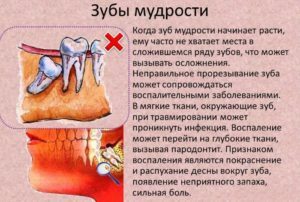 The retina tooth prevents normal chewing.
The retina tooth prevents normal chewing.
The close proximity of a healthy and curved molar leads to the formation of pulpitis.
Constant irritation of nerve endings causes intolerable pain and requires urgent medical intervention.
Retention can be complete and partial:
- When the is complete, the tooth remains inside the gum. It can be detected only by palpation and radiographic studies. A full retention indicates that the wisdom tooth lies horizontally.
- With partial , part of the tooth comes to the surface. As a rule, this happens when the molar rudiments are laid at an angle. In this case, the wisdom tooth grows on the cheek, in the side or in the adjacent tooth.
Possible complications of
With due treatment complications are rare. But in the running phase, the following processes may occur:
-
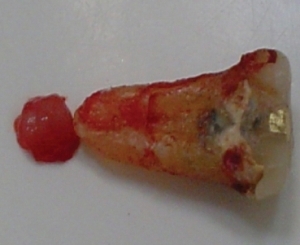 alveolitis - is the result of improper removal of the tooth. When extracting a horizontal molar, it is necessary to significantly dissect the gum, which increases the risk of infection;
alveolitis - is the result of improper removal of the tooth. When extracting a horizontal molar, it is necessary to significantly dissect the gum, which increases the risk of infection; - cyst formation - occurs due to infection in the root canals;
- root resorption of adjacent teeth - is the result of prolonged inflammation and mechanical impact of the wisdom tooth on the roots of closely located molars;
- changing facial proportions - swelling and destruction of the gums cause impairment of the facial contour;
-
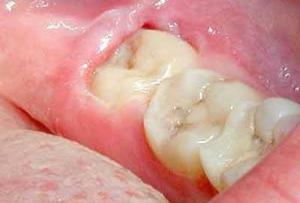 caries complication - the processes accompanying the eruption of the retinated tooth, aggravate the existing caries and promote the development of its cervical forms,
caries complication - the processes accompanying the eruption of the retinated tooth, aggravate the existing caries and promote the development of its cervical forms, - pinching of the nerve endings - leads to numbness of the jaw. With appropriate treatment, tissue paralysis quickly passes;
- pericoronitis - inflammation of the hood of the gum with possible abscess;
- acute periodontitis - tissue damage around the root of the tooth, accompanied by severe pain;
- bite anomaly - deformation of the jaw can lead to violation of chewing functions;
What if the tooth grows on the cheek?
Treatment of retention is possible with minor deformations. If the tooth erupts badly due to the characteristics of the gum, then it is excised, releasing the fully formed molar outward. In all other cases, tooth extraction is recommended.
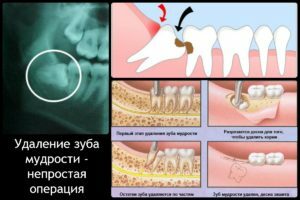 Inconvenient disposition of the tooth complicates its extraction. Together with the wrong trajectory of growth, the process of removing the wisdom tooth is even more difficult.
Inconvenient disposition of the tooth complicates its extraction. Together with the wrong trajectory of growth, the process of removing the wisdom tooth is even more difficult.
In the presence of an inflammatory process, an antibacterial therapy is prescribed before removal. The best time to extract a tooth is considered to be morning - for a day the pain should pass or fall to the acceptable level.
The affected area is treated with an antiseptic compound, anesthesia is performed. Typically, topical preparations are prescribed, but with a complex and prolonged removal consisting of several steps, general anesthesia can be used.
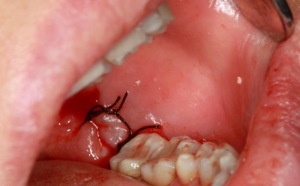
In the photo, the sutured gum is removed after removal of the
. Next, a gum incision is made and the tooth is split into parts. Removal of individual parts is carried out in stages. After extraction of all parts of the tooth, the wound is treated with antibacterial drugs. The gums sew up.
In modern dentistry, completely soluble materials are used, which do not require the subsequent removal of joints. The operation is considered complete after a complete stop of the bleeding.
Removing a wisdom tooth is always accompanied by a number of difficulties. Doctors recommend not delaying with the removal of eighth molars due to the risk of complications. In addition, with age, the gum thickens considerably, and the roots of the tooth become very large.
Typically, these symptoms indicate the onset of inflammation caused by infection in the well. The remaining fragments of teeth and cystic formations on tops of the roots of neighboring molars can lead to suppuration of the wound, preventing its healing.
After repeated cleaning of the hole, antibacterial therapy and home rinse products are prescribed, which should be used no earlier than one day after the operation.
Removing an improperly placed tooth of wisdom - details on the video:
Post-operative recommendations of the dentist
The risk of developing inflammation after removal of the retinas is very great. To improve the healing of dentists, it is recommended to adhere to the following rules:
- do not eat food earlier than 3 hours later;
- until complete recovery is recommended to use only puree foods in a warm form;
-
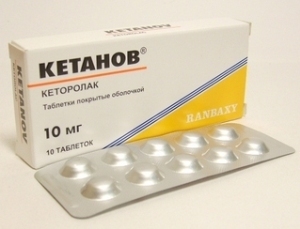 do not grimace and do not laugh, so as not to break the seams and deform the gum;
do not grimace and do not laugh, so as not to break the seams and deform the gum; - Do not touch the hole with fingers or foreign objects;
- with strong pain during the first 24 hours after the operation, you can use pain medication as agreed with your doctor;
- , after tightening the wells, antiseptic rinsing agents that prevent inflammation can be recommended;
- do not use warming compresses and heaters to relieve pain and swelling, if necessary, a doctor may be prescribed cold;
- to reduce physical activity in the first day after removal.
